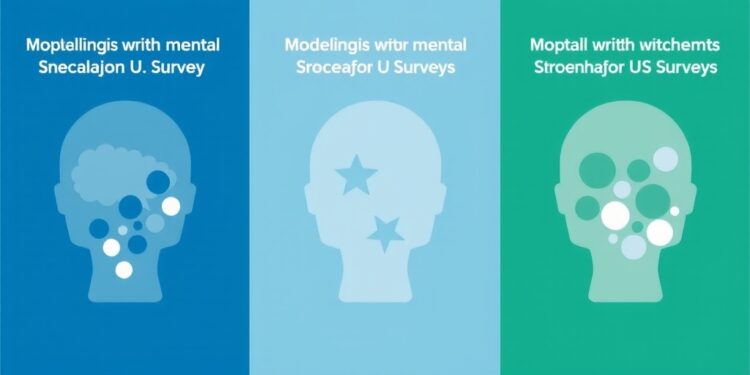
The recent survey study published in JAMA Network Open sheds light on a concerning trend: a significant rise in poor mental health among populations in the United States from 2011 to 2022. This comprehensive research draws from multiple health surveys, highlighting critical differences in mental health outcomes as documented by the Behavioral Risk Factor Surveillance System (BRFSS) and the National Survey on Drug Use and Health (NSDUH) in comparison to the National Health Interview Survey (NHIS).
The disparities revealed by the study underscore the complexity of mental health issues in America and reflect not just individual circumstances but broader systemic inequities. The research indicates that between 2011 and 2022, there has been an alarming increase in mental health issues, exacerbated by socio-economic factors and access to health resources. Furthermore, these disparities were notably influenced by age, gender, and racial and ethnic backgrounds, suggesting that certain demographic groups are disproportionately affected.
An examination of this data reveals that as time progressed, the mental health landscape continued to evolve. The survey outcomes demonstrate notable variations across different surveys, pointing to a potential divergence in how mental health is perceived and reported. For instance, while the BRFSS and NSDUH reported heightened levels of mental distress, the NHIS provided a different narrative, pointing to the importance of understanding how methodology and survey design can influence reported outcomes.
In discussing age-related disparities, the study found that younger populations, particularly those in their late teens and early twenties, reported the highest levels of mental health problems. This is reflective of broader societal issues such as increased academic pressure, social media impact, and economic uncertainty that disproportionately affect younger individuals. Additionally, the findings call into question the effectiveness of current preventive measures and mental health support systems, emphasizing the need for targeted interventions that address the specific needs of younger demographics.
Gender disparities also played a crucial role in the study’s findings. Women consistently reported higher levels of anxiety and depression compared to men, suggesting that gender-specific factors such as societal expectations and roles may contribute to this trend. The research reinstates the importance of tailoring mental health resources to consider these differences, as generic solutions may not effectively meet the needs of all demographics.
Racial and ethnic disparities, highlighted in the study, further complicate the mental health narrative in the U.S. Minority populations often face additional barriers to accessing mental health care, including stigma, cultural differences, and systemic inequalities. These barriers perpetuate a cycle where mental health issues are not adequately identified or treated, leading to poorer overall outcomes for these groups.
Significantly, the authors of the study assert that addressing these inequities requires a multifaceted approach. Strategies must encompass education, community engagement, and policy reform aimed at improving access to mental health resources for marginalized groups. These efforts can help bridge gaps and alleviate some of the pressures that contribute to poor mental health outcomes.
The implications of this study extend beyond mere statistics. They highlight a national health crisis that demands urgent attention from policymakers, healthcare providers, and society as a whole. As the prevalence of mental health issues continues to rise, it becomes increasingly clear that a comprehensive understanding of the factors driving these trends is essential for implementing effective solutions.
Furthermore, the study raises important questions about how the COVID-19 pandemic has intersected with these findings. While data prior to the pandemic focused on existing disparities, the subsequent years have likely compounded these issues due to increased social isolation, economic instability, and a heightened sense of uncertainty. Exploring these connections will be crucial in addressing the long-term impact of the pandemic on mental health.
As researchers work to unravel the complexities associated with mental health trends, continued collaboration across disciplines will be vital. Social scientists, healthcare professionals, and community organizations must unite to create a holistic understanding of the challenges at hand. This multidisciplinary approach can foster innovative solutions that can be implemented on community and national levels.
Rita Hamad, MD, PhD, the corresponding author of the study, emphasizes the importance of these findings in guiding future research and policy directions. She advocates for more extensive studies that not only assess the prevalence of mental health issues but also scrutinize the effectiveness of existing treatment and prevention programs. It is only through such rigorous examination that stakeholders can ensure that mental health support is equitable and accessible to all.
As mental health continues to dominate public discourse, this study serves as a timely reminder of the work still needed to address the escalating crisis. The need for systemic changes has never been more pressing, as society must reevaluate how it addresses mental health to create supportive environments that promote well-being for everyone.
This research study not only documents current mental health trends but also serves as a call to action. It invites individuals, communities, and governments to engage in committed efforts aimed at understanding and mitigating the factors contributing to this public health emergency. Through sustained efforts and collaboration, there is hope for creating a future where mental health resources are equitable and effective, fostering a healthier and more resilient population.
Subject of Research: The prevalence of poor mental health across demographic groups in the U.S. from 2011 to 2022.
Article Title: Not provided.
News Publication Date: Not provided.
Web References: Not provided.
References: Not provided.
Image Credits: Not provided.
Keywords: Mental health, disparities, socioeconomic factors, women, youth, racial and ethnic differences, public health.





